VP Vice and 001 Pedal Comparison April 22 2013, 0 Comments
I have been riding flat, non retaining system, pedals for a long time. Most of my youth, and for recent years thanks to Grant at Rivendell, I have been pedaling free. There are a variety of options at the full range of price points. At the lower end you can get very basic touring or BMX pedals with decent traction for $20. The upper end is dominated by very thin machined aluminum mountain bike race pedals these go well up into the $hundreds with exotic materials in the pursuit of weight savings and thinness. I have been testing a range off offerings in pursuit of offering a pedal that strikes a balance of performance and value. What are things I consider key?- Wide and long platform for maximum foot support. This puts much of the stiffness burden back on the pedal and reduces or completely removes the need for stiffness in the shoe.
- Traction pins that are integral to the design, easily replaceable and in useful places. The pins keep you foot from slipping off of the pedal. There are lots of types, from cast in to screws that come in from the top or bottom.
- Sealed Cartridge bearings. This is where the price can go up fast compared to basic pedals. While most pedals can be serviced and last a life time, good seals and bearings increase the time between servicing as well as the ease of the process.
- Thinness. As downhill and dirt jumping have dominated this pedal market segment the pedals keep getting thinner. Older pedals are generally 25-30mm thick. The newest versions are 5-15mm thick. Thinner pedals get you closer to the ground. The change of center of gravity is probably insignificant, but you are 5-10mm closer to the ground and that helps to get more than the tip of your toe on the ground at a stop while your rear is still on the saddle. The truly ultra thin pedals generally make compromises in the bearing and spindle design to achieve the thinness.
 Red VP001 and Blue VP Vice[/caption]
Red VP001 and Blue VP Vice[/caption]
Both are good pedals for about $65-70 street price. Both are a bit wider than some other common pedals, MKS Grip King (lambda) and RMX "sneeker" pedals, as well as have more aggressive pins. The following comparison pictures tell the story.
[caption id="attachment_3669" align="aligncenter" width="640"]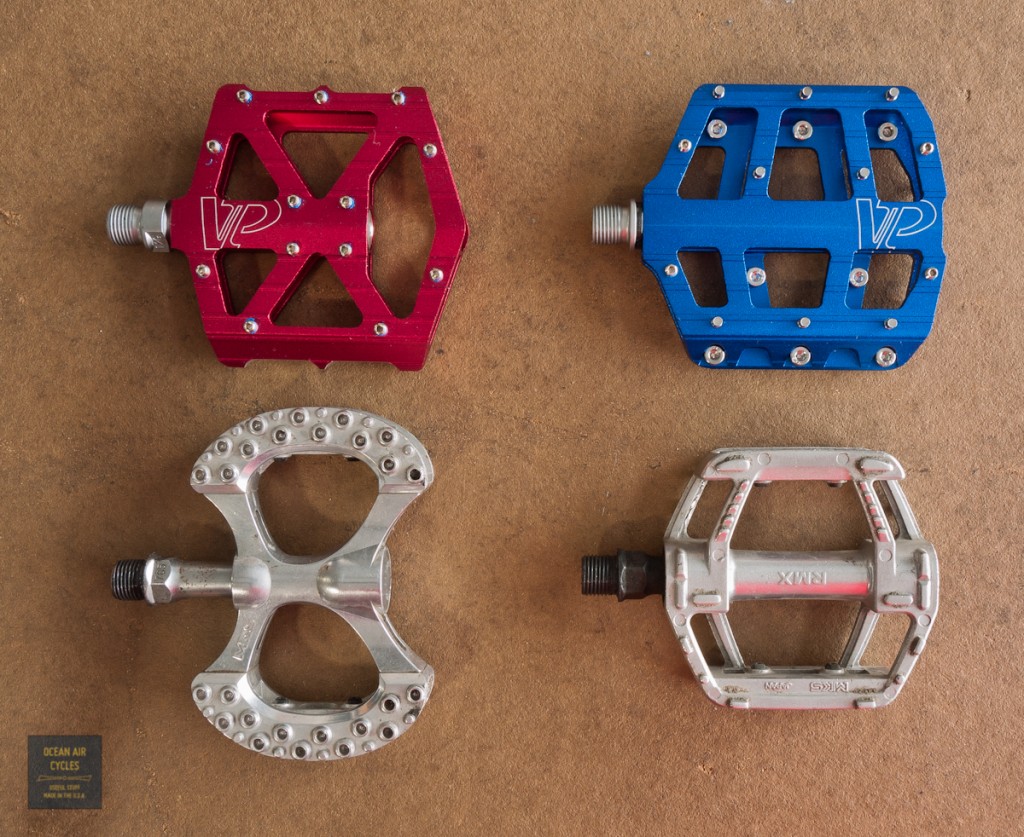 Red VP001 and Blue VP Vice[/caption]
Red VP001 and Blue VP Vice[/caption]
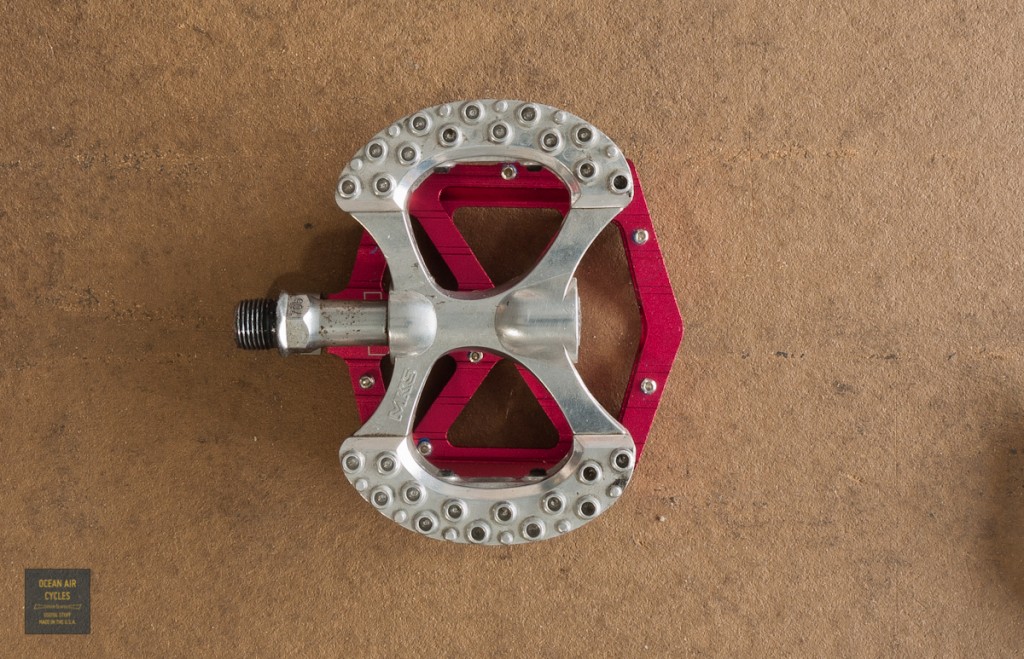
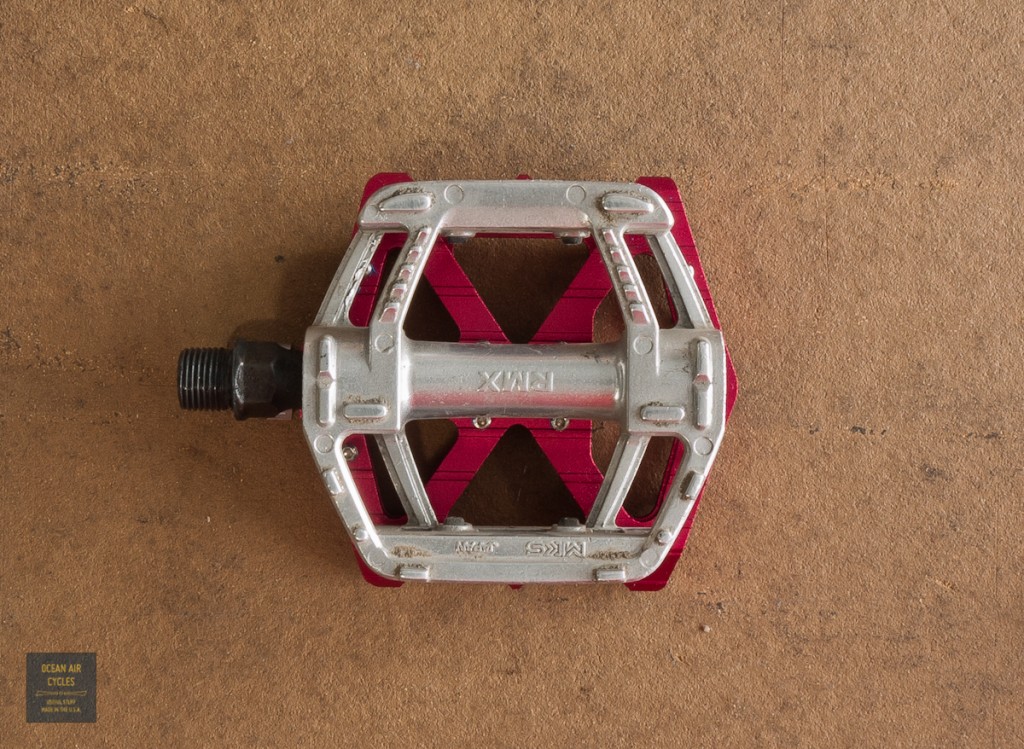
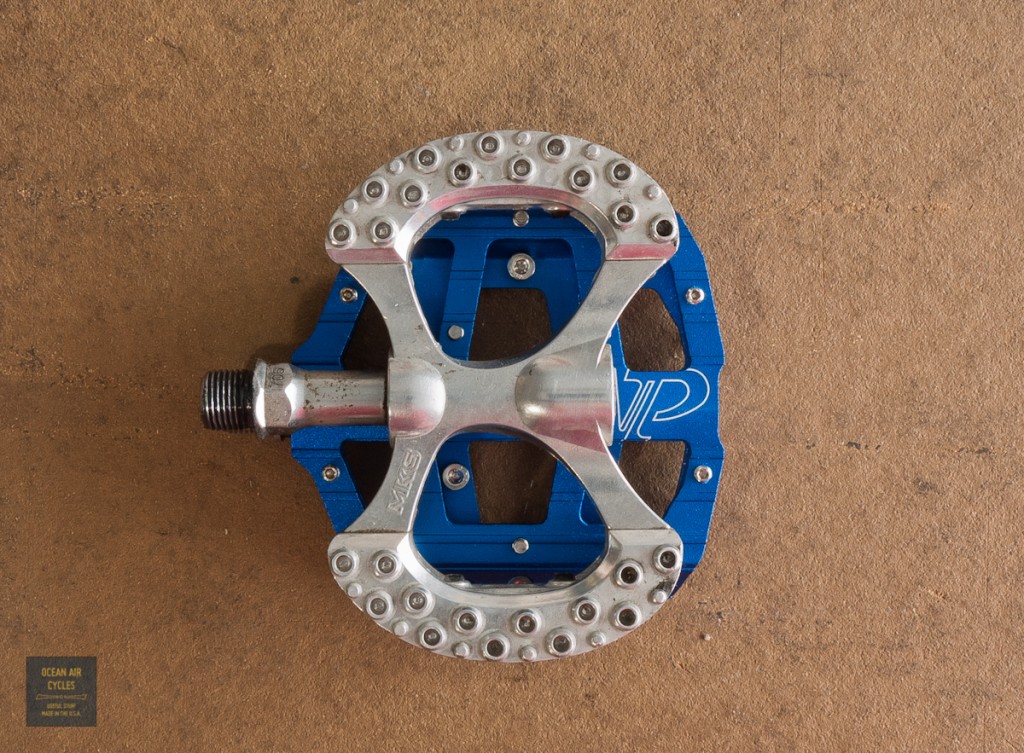
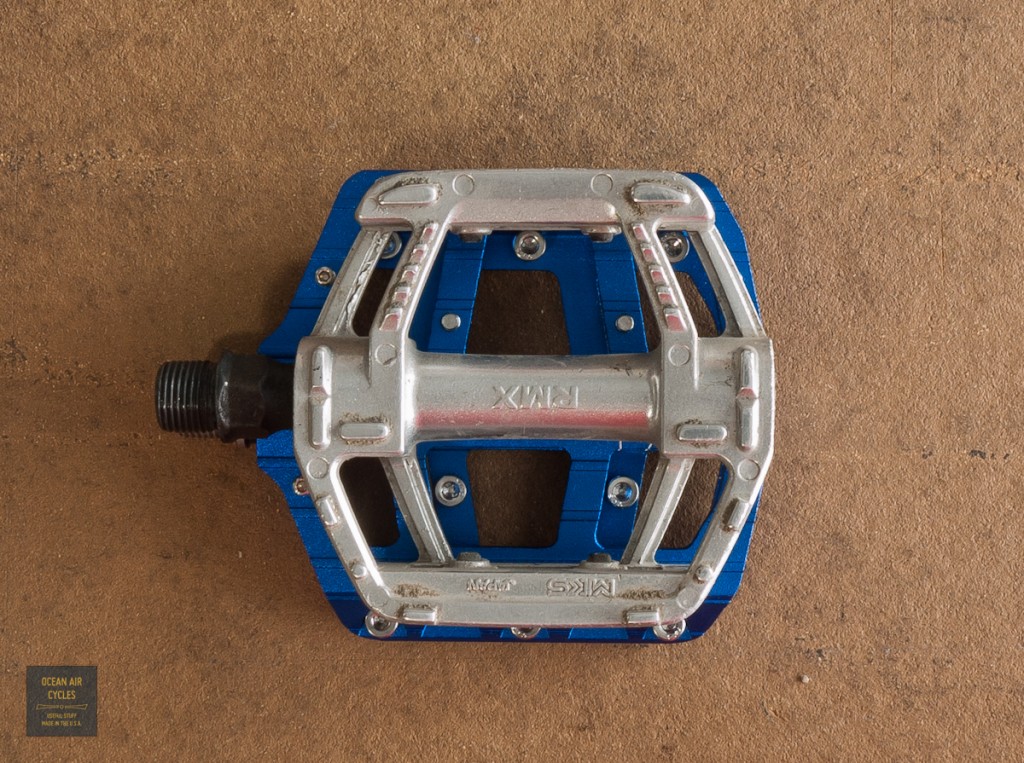 The difference in thinness is remarkable. The MKS pedals are 26mm while the VP are 16mm. The means your saddle height will come down 5mm and your toe will me 5mm closer to the ground at a stop without bringing the pedal any closer to the ground or threatening a strike.
The difference in thinness is remarkable. The MKS pedals are 26mm while the VP are 16mm. The means your saddle height will come down 5mm and your toe will me 5mm closer to the ground at a stop without bringing the pedal any closer to the ground or threatening a strike.
 Red VP001 and Blue VP Vice[/caption]
Red VP001 and Blue VP Vice[/caption]
There are also some subtle but important differences between the VP-001 and the Vice. For me the Vise is the clear winner. The VP-001 has a more traditional spindle that allows the pedal to be installed with a 6mm allen wrench or traditional 15mm pedal wrench. The Vise on the other hand requires a 8mm key. Why the difference? The vice allows the whole platform to sit closer to the crank arm, and thus your foot closer reducing the overall Q-factor. Q is the distance between crank arms, narrower Q generally feels more normal, and is used in traditional road biking designs.
[caption id="attachment_3668" align="aligncenter" width="640"]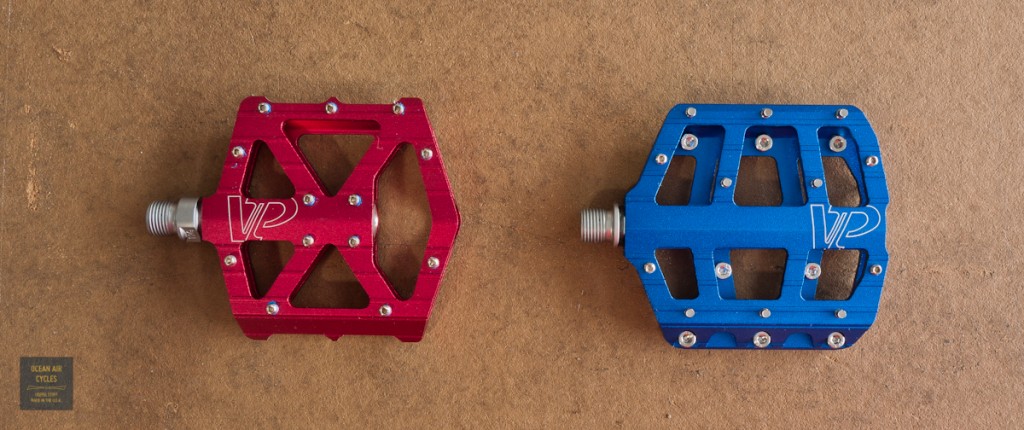 Red VP001 and Blue VP Vice[/caption]
Red VP001 and Blue VP Vice[/caption]
The platforms are both quite large compared to traditional pedals. Compared to each other the Vice has more supporting area at the outer corners as well as through the center of the platform.
[caption id="attachment_3670" align="aligncenter" width="640"] Red VP001 and Blue VP Vice[/caption]
[caption id="attachment_3671" align="aligncenter" width="640"]
Red VP001 and Blue VP Vice[/caption]
[caption id="attachment_3671" align="aligncenter" width="640"]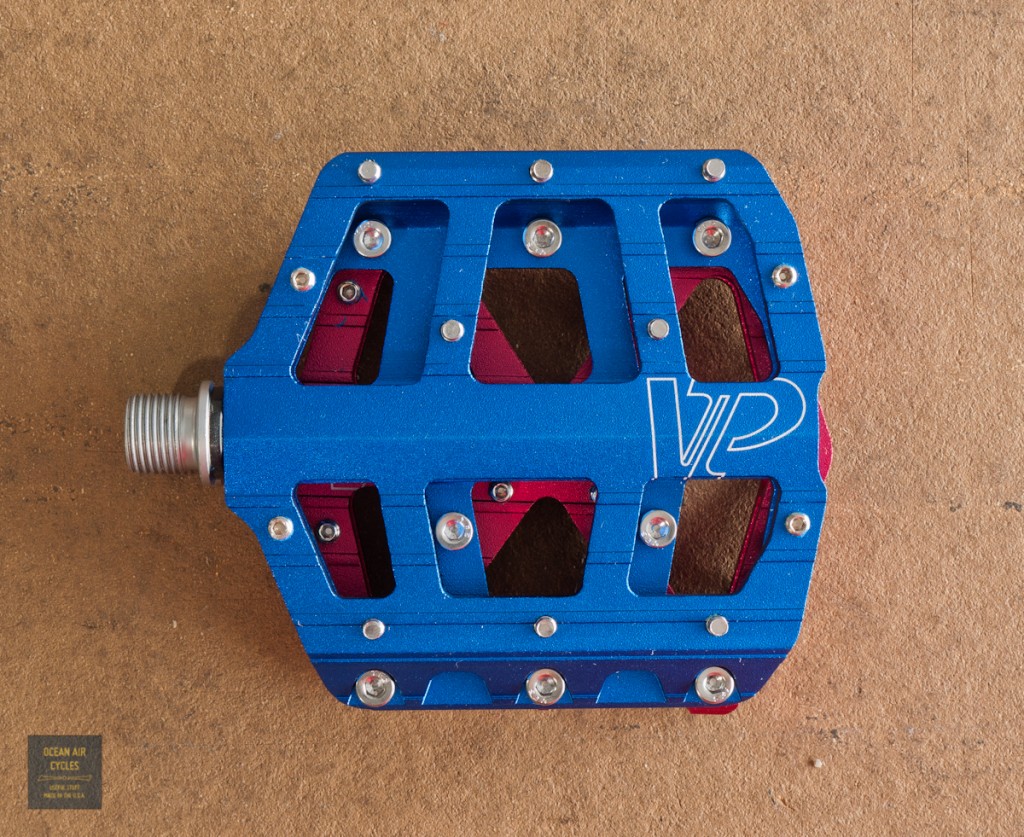 Red VP001 and Blue VP Vice[/caption]
Red VP001 and Blue VP Vice[/caption]
The axle on the Vice is longer and the outboard bearing is placed a full 2cm further out board from the crank arm. This will reduce the loading on the bearing reducing wear and time between service.
[caption id="attachment_3678" align="aligncenter" width="640"]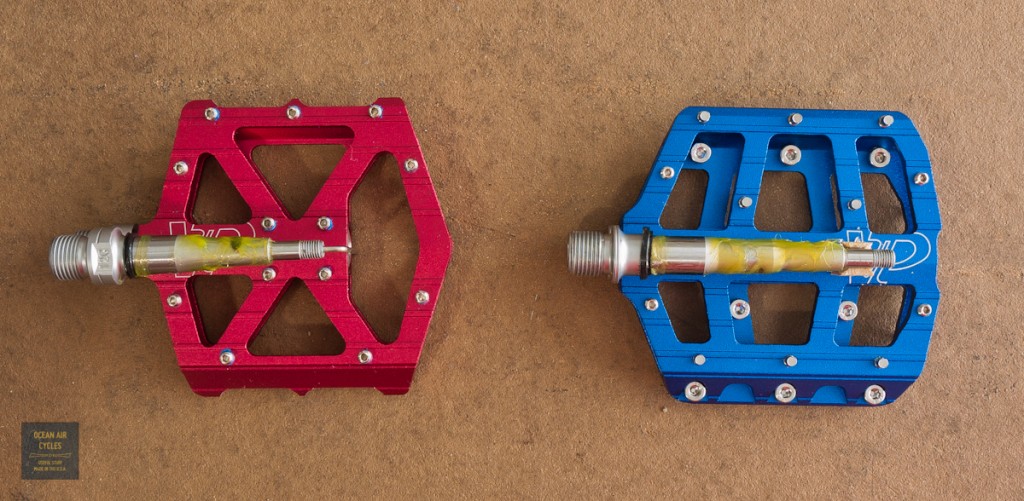 Red VP001 and Blue VP Vice[/caption]
Red VP001 and Blue VP Vice[/caption]
 The last and a notable difference is the type and placement of the pins. The VP-001 uses grub or set screws that are inserted from the top. The hole for the wrench to remove and replace these can clog with crud and or be damaged from impact increasing the difficulty of replacement. The Vice uses a combination of M4 bolts that come in from the underside of the platform and the above mentioned grub screws. You can get rid of the grub screws and still have plenty of traction for touring and road riding. The M4 bolts allow a better platform for replacement or tinkering with different lengths etc. The stock M4 bolts are custom ground into pins, replacements are available, but an average M4 bolt from the store will work fine.
The last and a notable difference is the type and placement of the pins. The VP-001 uses grub or set screws that are inserted from the top. The hole for the wrench to remove and replace these can clog with crud and or be damaged from impact increasing the difficulty of replacement. The Vice uses a combination of M4 bolts that come in from the underside of the platform and the above mentioned grub screws. You can get rid of the grub screws and still have plenty of traction for touring and road riding. The M4 bolts allow a better platform for replacement or tinkering with different lengths etc. The stock M4 bolts are custom ground into pins, replacements are available, but an average M4 bolt from the store will work fine.

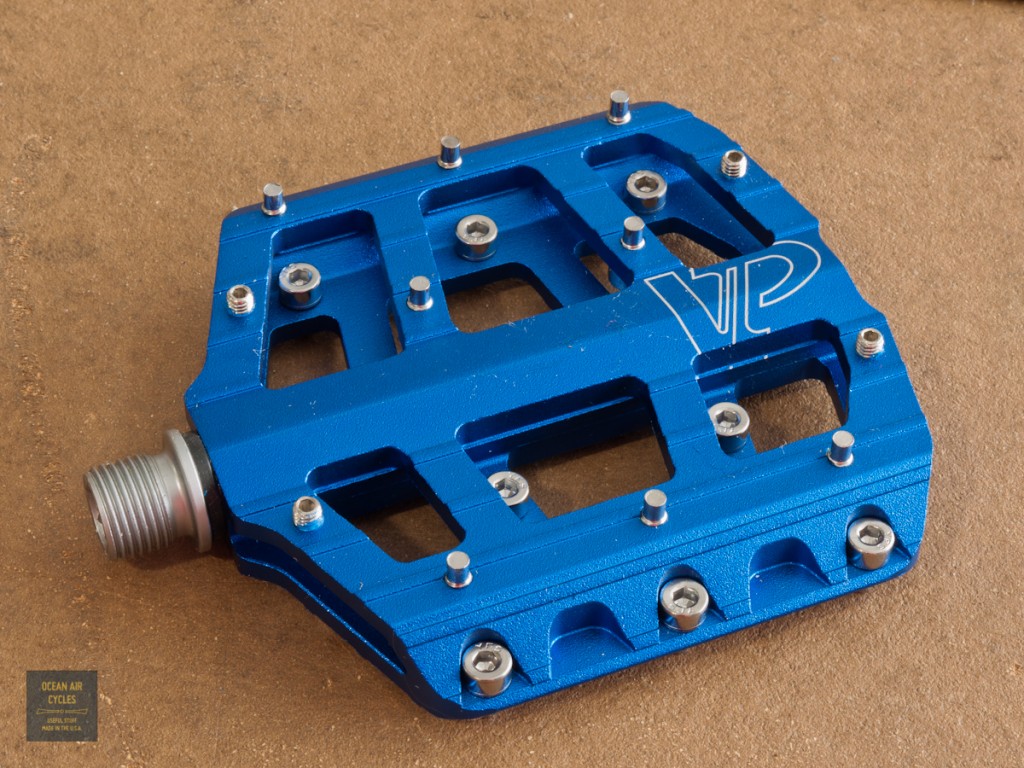 The things that I see as improvements in the Vice over the 001 do come at a price. The Vice is 28-30g heavier per pedal and the price is $5 more. For the truly weight conscious there are Ti replacement spindles that will shave 35g per pedal. Fine tuning the pins could sheave even more. While both pedals are well overbuilt for street riding and touring, the added value of the Vice makes it the standout in my mind.
Bottom Line....I have been loving my pair of vices, plan on riding the heck out of them for a long time and will be adding the Vice pedals to the storefront this afternoon.
Ride free in the shoes that you like to walk in, it makes it more fun to ride to the places you are going during the day. The change in riding speed really is insignificant from the majority of us, and did I mention that you are likely to have more FUN?
The things that I see as improvements in the Vice over the 001 do come at a price. The Vice is 28-30g heavier per pedal and the price is $5 more. For the truly weight conscious there are Ti replacement spindles that will shave 35g per pedal. Fine tuning the pins could sheave even more. While both pedals are well overbuilt for street riding and touring, the added value of the Vice makes it the standout in my mind.
Bottom Line....I have been loving my pair of vices, plan on riding the heck out of them for a long time and will be adding the Vice pedals to the storefront this afternoon.
Ride free in the shoes that you like to walk in, it makes it more fun to ride to the places you are going during the day. The change in riding speed really is insignificant from the majority of us, and did I mention that you are likely to have more FUN?